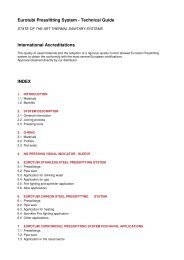corrosion of stainless steel - Damstahl
corrosion of stainless steel - Damstahl
corrosion of stainless steel - Damstahl
You also want an ePaper? Increase the reach of your titles
YUMPU automatically turns print PDFs into web optimized ePapers that Google loves.
Chapter 6 - Corrosion <strong>of</strong> Stainless Steel<br />
6.1.2 Environmental Factors in Acids<br />
The risk <strong>of</strong> general <strong>corrosion</strong> <strong>of</strong> <strong>stainless</strong> <strong>steel</strong>s exposed to acids normally<br />
depends on:<br />
The acid type and concentration (acidity, pH)<br />
The acid's oxidation capacity<br />
Temperature<br />
Type and concentration <strong>of</strong> impurities<br />
Most <strong>of</strong>ten: The<br />
higher the acid<br />
concentration, the<br />
worse the <strong>corrosion</strong><br />
Oxidising and<br />
non-oxidising<br />
acids<br />
The acid's concentration is not as unequivocal as might be expected. For<br />
most types <strong>of</strong> acid, higher concentrations generally mean greater weight loss<br />
<strong>of</strong> the <strong>steel</strong>. However, at extremely high acid concentrations - e.g. > 90% <strong>of</strong><br />
sulphuric acid (H 2<br />
SO 4<br />
) - the lack <strong>of</strong> water actually results in the acid failing<br />
to function properly as an acid, which is to say that water is thus the limiting<br />
factor. This is only the case, however, with sulphuric acid; for almost all other<br />
acids, the following general rule applies: The higher the concentration, the<br />
worse the <strong>corrosion</strong>.<br />
For all non-passivating alloys, it generally follows that the more active the<br />
cathode reaction (see Chapter 5), the worse the <strong>corrosion</strong>, though this is<br />
not necessarily the case with passive alloys. The formation <strong>of</strong> passivating<br />
chromium oxides requires a certain oxidising effect, and, up to a certain<br />
limit, <strong>stainless</strong> <strong>steel</strong> thus performs better in oxidising acids than in nonoxidising<br />
acids.<br />
This effect is illustrated in Figure 5.8 on page 64, where the strong, nonoxidising<br />
acids (sulphuric acid, phosphoric acid, etc.) will typically make<br />
the <strong>steel</strong> fall into the yellow ”active area” with resulting high <strong>corrosion</strong><br />
rates. An oxidising acid, on the other hand, such as a pure nitric acid or<br />
peracetic acid will make the <strong>steel</strong> jump up into the green ”passive area”<br />
where the <strong>corrosion</strong> rate is far lower despite the higher potential (and thereby<br />
theoretically greater driving force). The <strong>corrosion</strong> rate is not only governed<br />
by energy, but just as much by kinetics.<br />
This effect is clearly seen with <strong>stainless</strong> <strong>steel</strong> in sulphuric acid (see<br />
Figure 6.3) where even small amounts <strong>of</strong> the highly oxidising chromic acid,<br />
CrO 3<br />
, has a strong inhibiting effect on the <strong>corrosion</strong> <strong>of</strong> 4307 <strong>steel</strong>. This is<br />
seen by the curve's high location in relation to the pure sulphuric acid. If the<br />
concentration <strong>of</strong> CrO 3<br />
is increased beyond the indicated 0.2-0.5%, the curve<br />
will fall again as a sign <strong>of</strong> ”overdosing”. Other oxidants such as hydrogen<br />
peroxide (H 2<br />
O 2<br />
) has the same beneficial effect and can therefore be used as<br />
a <strong>corrosion</strong> inhibitor in sulphuric acid. Perioxide-inhibited sulphuric acid<br />
is <strong>of</strong>ten used as a substitute for nitric acid in applications where remains<br />
<strong>of</strong> nitrates (NO 3–<br />
) for various reasons are unwelcome, e.g. in the cleaning<br />
<strong>of</strong> milk tanks.<br />
77<br />
RS for alle.indb 77<br />
9/29/2011 12:44:33 PM

















